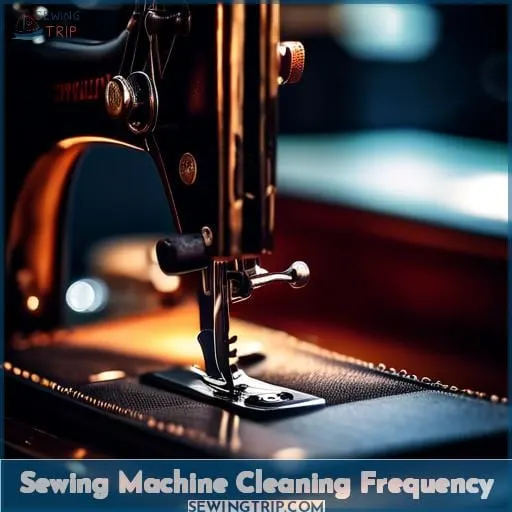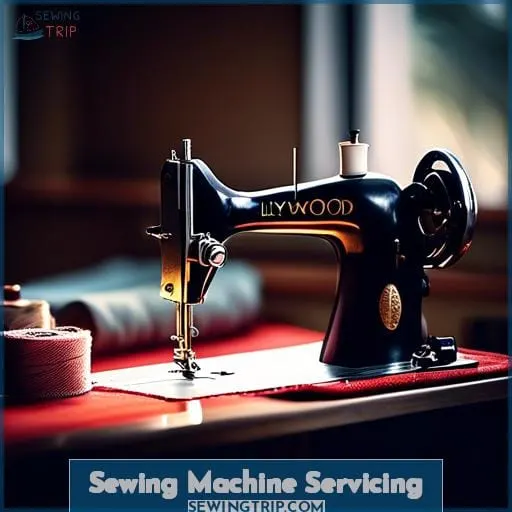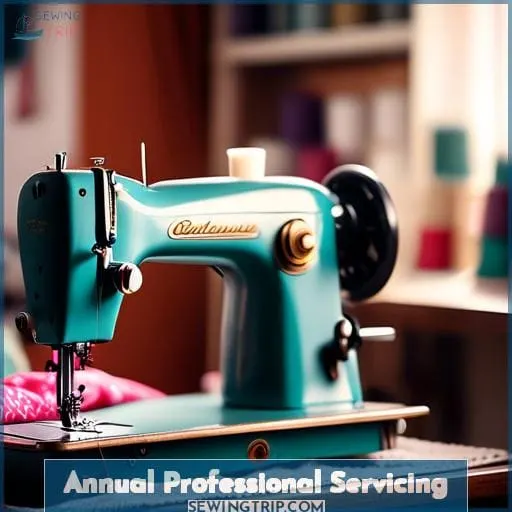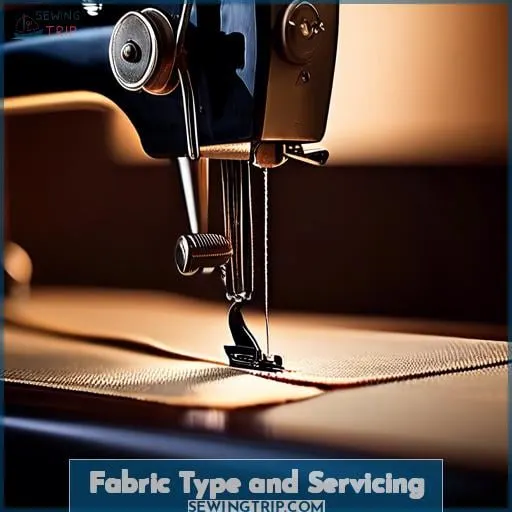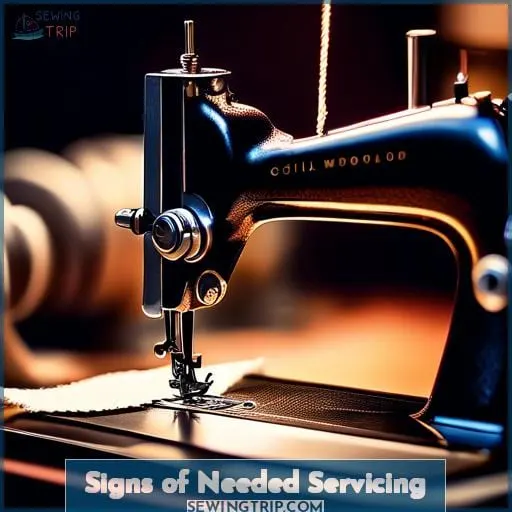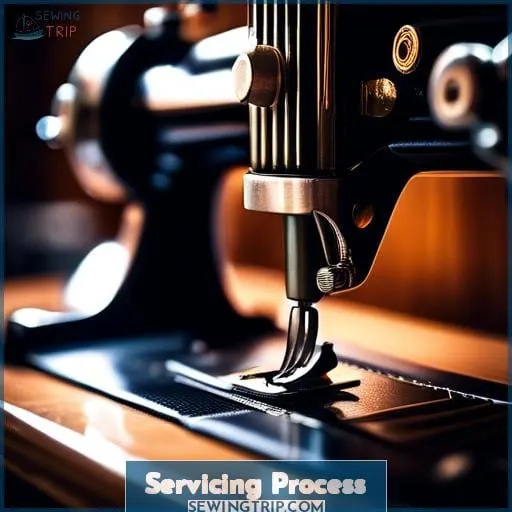This site is supported by our readers. We may earn a commission, at no cost to you, if you purchase through links.
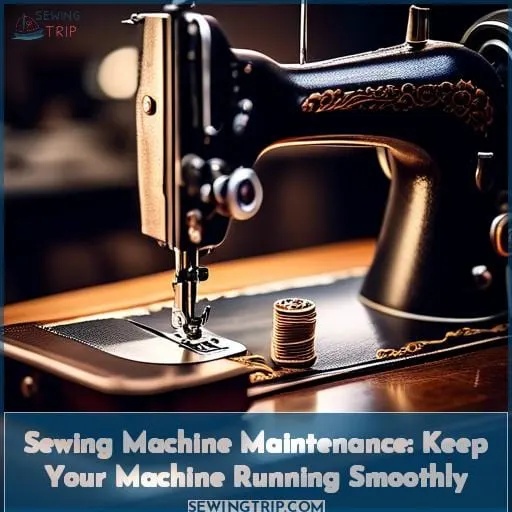 Maintaining your sewing machine is crucial for ensuring its longevity and performance. Just like any other tool, your sewing machine requires regular care to prevent issues and keep it running smoothly.
Maintaining your sewing machine is crucial for ensuring its longevity and performance. Just like any other tool, your sewing machine requires regular care to prevent issues and keep it running smoothly.
Whether you’re a seasoned sewer or just starting out, understanding the importance of servicing your sewing machine can make a significant difference in your crafting experience. This guide will delve into the essentials of sewing machine maintenance, from lint removal to recognizing when it’s time for professional servicing.
By adhering to a maintenance schedule and being mindful of the signs that your machine needs attention, you can enhance your sewing experience and extend the life of your machine. Let’s explore how to keep your sewing machine in top condition, ensuring that it remains a reliable companion in all your sewing endeavors.
Table Of Contents
- Key Takeaways
- Do Sewing Machines Need Servicing
- Lint Build Up Removal
- Sewing Machine Cleaning Frequency
- Sewing Machine Servicing
- Annual Professional Servicing
- Usage Intensity and Servicing
- Fabric Type and Servicing
- Regular Maintenance and Age
- Signs of Needed Servicing
- Servicing Process
- Specific Servicing for Different Machine Types
- Frequently Asked Questions (FAQs)
- Conclusion
Key Takeaways
- Regular cleaning and oiling of the sewing machine are essential for maintaining performance and extending its lifespan. Users should clean the bobbin compartment and under the throat plate after every 2-3 bobbins and oil the machine as per the manufacturer’s instructions.
- Sewing machines should be serviced regularly, with the frequency depending on the intensity of use. Daily users should aim for weekly cleaning and oiling, while less frequent users can do so monthly.
- Professional servicing should be done annually and includes a deep clean, oiling, tension adjustments, and timing checks. This helps to extend the machine’s lifespan and prevent costly repairs.
- Signs that a sewing machine needs servicing include unusual sounds, resistance in the handwheel, tension issues, skipped stitches, or broken threads. Servicing needs can also be influenced by the machine’s age and usage intensity.
Do Sewing Machines Need Servicing

Yes, sewing machines need servicing to ensure they run smoothly and prevent issues from wear and tear. Regular maintenance, including lint removal and oiling, is recommended, with professional servicing advised annually.
Lint Build Up Removal
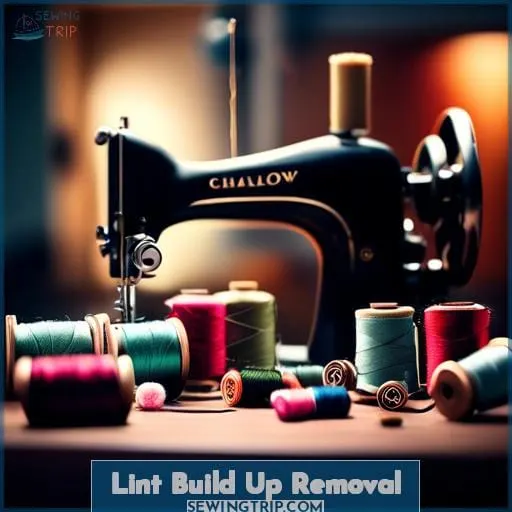
To keep your sewing machine in tip-top shape, regular lint removal is a must. Imagine your machine as a high-performance car; it needs a clean engine to purr smoothly.
Start by unplugging your machine to avoid any unexpected stitches in your fingers. Whip out your trusty brush and play detective, hunting down every fluff culprit hiding in the nooks and crannies of the bobbin compartment.
It’s like giving your machine a spa day; a little pampering can go a long way. So, next time you’re done stitching up a storm, take a moment for lint management.
Sewing Machine Cleaning Frequency
To maintain your sewing machine’s performance and longevity, it’s crucial to adhere to a regular cleaning schedule. Lint removal frequency is a key aspect of this routine. After every 2-3 bobbins, take a moment to clear out the fluff from the bobbin compartment and under the throat plate.
This isn’t just busywork; it prevents those pesky skipped stitches and the dreaded thread break mid-seam.
When it comes to oiling, think of your sewing machine as a trusty car that needs its oil changed to purr along smoothly. Check your manual for the VIP spots that crave a drop or two of that golden lubricant.
And don’t even consider substituting with kitchen oil; your machine deserves the real deal—sewing machine oil.
The frequency of this tender loving care depends on how often you and your machine tango. Daily users should aim for a weekly spa session, while weekend warriors can stretch it to monthly. And if you’re more of an occasional seamstress, a biannual clean and oil should suffice.
But let’s not forget, heavy fabrics and those that shed more than a winter coat will demand more frequent attention.
Beyond the DIY maintenance, your machine needs an annual check-up with a professional—think of it as a wellness visit to ensure everything’s ticking along nicely. This servicing includes a deep clean, oiling, tension adjustments, and a timing check, ensuring your machine stays in tip-top shape for all your sewing adventures.
Sewing Machine Servicing
Diving into sewing machine servicing, think of it as your machine’s spa day, minus the fluffy robes. Regular check-ups are crucial, not just for peace of mind but to keep your creative companion humming smoothly.
Wondering about the service cost? Prices can vary, but scouting local repair shops might land you a deal between £50-£100. If you’re a hands-on kind of person, DIY servicing is an option—just make sure it doesn’t void your warranty.
For those pesky problems that have you scratching your head, troubleshooting guides can be lifesavers. Remember, how often to service your sewing machine depends on how much you use it.
Lastly, don’t forget to soak up sewing machine tips; they’re golden nuggets that can save you time and money.
Annual Professional Servicing
When your trusty sewing machine starts to grumble or groan, it’s hinting that it’s time for its annual check-up. Think of professional servicing as a spa day for your machine—where it gets pampered and tuned to ensure it keeps running like a dream.
Local repair shops can be goldmines for this, often offering a more personal touch than larger stores.
Sure, you might consider wielding a screwdriver for some DIY servicing, but beware—the risks can outweigh the savings, especially if you’re not well-versed in sewing machine troubleshooting.
Always consult your sewing machine manual before attempting any heroics with the needle or thread; sometimes, it’s best to leave it to the pros.
Usage Intensity and Servicing
Just wrapped up your annual servicing chat, huh? Well, let’s dive into how usage intensity shakes things up in the sewing machine maintenance game.
Picture this: your machine’s humming along, stitching through heavy fabrics like a hot knife through butter. But, oh boy, those fabrics are shedding more than a long-haired cat in summer! This means you’re looking at upping your servicing frequency.
It’s not just about the calendar; it’s how hard and often you’re pushing your machine.
Think of it like a car; the more miles, the more maintenance. And if your trusty stitcher is getting on in years or starting to sound like a garage band at practice, it’s screaming for some TLC. Don’t wait for a breakdown; regular check-ups can save you from the dreaded long-term storage blues.
Keep that machine purring, and it’ll keep your creativity flowing.
Fabric Type and Servicing
When you’re stitching through heavy fabrics, your sewing machine works overtime. The denser the material, the more strain on your machine, which can lead to more frequent servicing needs.
- Heavy fabrics require more lubrication to keep parts moving smoothly.
- Skipping stitches or broken threads? It’s a cry for help—your machine’s tension and timing might be off.
- Don’t wait for the bobbin to stage a protest; sewing machine servicing should be proactive, especially with challenging fabric types.
Regular Maintenance and Age
In the journey of sewing machine upkeep, think of regular maintenance as your machine’s fountain of youth. It’s the secret sauce to extending its lifespan and ensuring it ages gracefully. Regular care not only keeps your machine humming smoothly but can also stretch out those service intervals, saving you a trip to the repair shop.
| Maintenance Frequency | Machine Longevity | Service Intervals |
|---|---|---|
| Regular Care | Increases | Lengthens |
| Neglect | Decreases | Shortens |
| Aging Effects | Manageable | Predictable |
Signs of Needed Servicing
Recognizing when your sewing machine is crying out for help is key to maintaining its smooth operation.
- Unusual Sounds: If your machine starts to sound like a grumpy cat instead of its usual purr, it’s time for a check-up.
- Handwheel Resistance: When turning the handwheel feels like arm-wrestling, your machine is begging for some TLC.
- Tension Issues: If your stitches are more moody than a teenager’s text messages, tension adjustments are overdue.
- Skipped Stitches or Broken Threads: These are as frustrating as a dropped internet connection right before your favorite show; don’t ignore them.
Don’t wait until your machine throws a full-blown tantrum. Listen to these whispers for a stitch in time!
Servicing Process
Diving into the servicing process of your sewing machine isn’t just about keeping it humming; it’s about ensuring its longevity and getting the most bang for your buck.
Think of it as a spa day for your machine, minus the cucumber slices. Regular check-ups can prevent those pesky, unexpected breakdowns.
If you’re feeling brave, DIY servicing can tackle the basics—just don’t void your warranty by going rogue. How often you pamper your machine depends on how much you’re putting it through its paces.
Specific Servicing for Different Machine Types
After diving into the nitty-gritty of the servicing process, let’s zero in on the unique needs of different sewing machine types. Each machine is a world unto itself, with quirks and requirements that demand a keen eye and a steady hand.
- Sergers need a watchful eye on looper timing and feed dogs to keep seams crisp and clean.
- Embroidery Machines thrive with regular checks on sensors and belt tension, ensuring designs are stitched out flawlessly.
- Walking Feet machines require a smooth glide, achievable through diligent oiling.
Frequently Asked Questions (FAQs)
How to diagnose sewing machine motor issues?
Listen up, if you’ve got a sewing machine motor on the fritz, first check the belt to make sure it’s not playing hooky.
If the belt is snug as a bug but still no go, grab a multimeter and play detective with the wiring.
Can dust covers prevent the need for servicing?
Dust covers are like superheroes for your sewing machine, warding off the evil dust and lint villains.
They can’t eliminate the need for servicing, but they’ll definitely cut down on the frequency.
Think of them as your machine’s trusty sidekick!
What are the risks of DIY electrical repairs?
When it comes to DIY electrical repairs on sewing machines, the risks are like a tangled bobbin waiting to unravel. Incorrect repairs can lead to electrical hazards, machine malfunctions, and costly damages.
Leave the intricate dance of wires to the pros.
How to identify worn out sewing machine parts?
To spot worn-out sewing machine parts, check for any visible wear like scratches or deformation.
Listen for unusual noises and feel for resistance in moving parts.
If stitches are uneven or skipping, it’s time to inspect.
Are there eco-friendly alternatives for machine lubricants?
Imagine you’re in your workshop, the smell of wood and oil in the air, and you’re about to give your trusty sewing machine some TLC.
You reach for a bottle of PlanetSafe Lubricants, knowing it’s not just good for your machine but also kind to the planet. This isn’t just any lubricant; it’s a testament to your commitment to sustainability and high performance.
Crafted with cutting-edge bio-synthetic nanotechnology, it forms an ionic bond with metal, ensuring your sewing machine runs smoothly in any condition, from freezing cold to scorching heat. It’s waterproof, dustproof, and practically anything-proof, all while being non-toxic and safe around your pets.
You’re not just maintaining your equipment; you’re making a choice for a healthier planet.
Conclusion
Your sewing machine is the unsung hero of your craft, tirelessly stitching through thick and thin. To ensure it continues to serve you faithfully, regular servicing is non-negotiable.
Keep up with cleaning after each project, schedule annual check-ups, and stay alert to any changes in performance. Different machines and usage patterns demand specific care, but with consistent maintenance, your trusty sewing machine will remain your steadfast ally in bringing creative visions to life.

